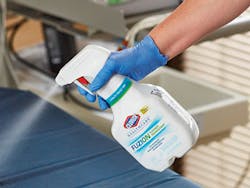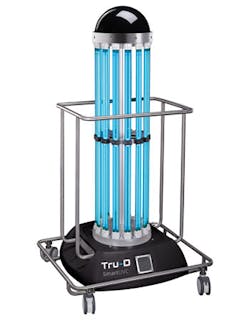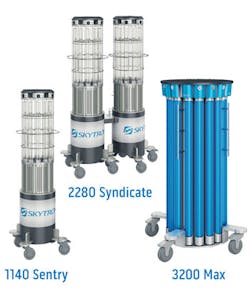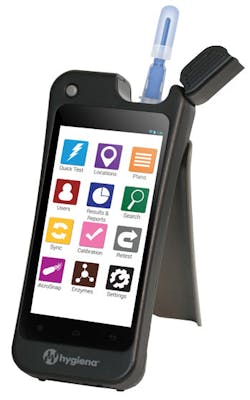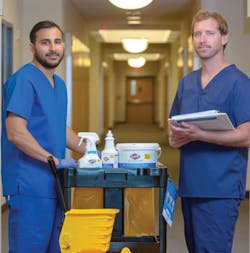The core mission of nearly every healthcare facility tends to be similar: Provide the best patient care experience possible at the best cost. Delivering the best patient care also includes implementing a strong patient safety component; but the way Hospital A achieves this goal compared to Hospital B may not be so similar.
Most patient safety initiatives include a solid infection prevention (IP) connection. This requires the steady engagement of and cooperation from several departments, including Environmental Services (EVS), which is indispensable to the effort because of the important role it plays in virtually every area it touches. Whether it be inside the patient room, the surgical suite, the emergency department, intensive care unit, or any other place under a hospital’s roof, EVS professionals have the critical job of making the entire healthcare space as clean and pathogen-free as possible.
A place to help people
Although some facilities may miss the mark in making this connection strong and clear within its workplace culture, many more have hit the bullseye by giving their EVS department the support, education and tools it needs to complete its work, along with some much-deserved recognition for jobs well done.
“Overall, the team’s transparency and 24/7 availability make it easy to obtain feedback so our EVS staff stay well-informed. This job is all about the patients and preventing HAIs. I speak for the entire EVS department when I say that Memorial is not a place to simply grab a check. This is a place to help people.”
In addition, Watson, one of the two first-ever CloroxPro Champions of Clean contest winners, says her EVS department at the Springfield IL organization provides ongoing training sessions, weekly policy procedure updates, and protocol quizzes. “Our leadership team is extremely approachable as well — I can always go to my supervisor with questions and our department director stays involved in day-to-day activities,” she said.
Does this mean problems don’t occur? Hardly. But when they do, department leaders at Memorial join forces and find ways to fix problems together, says Watson. “Room turnover used to be an issue, but we worked with the nursing staff and our placement office to ensure we remain focused on priority rooms,” she said. “We are a very busy hospital so it’s crucial we turn over rooms in an efficient and thorough way. In order to do this, our EVS department uses TeleTracking to keep track of hospital beds, incorporating the use of effective cleaning products, and establishing consistent cleaning protocols. We now average around 30 minutes per room, cutting our turnover time in half compared to eight years ago.”
Spreading the word
When asked what’s on her wish list, something she would like to make her job better or easier, Watson said other than regular use of Clorox Healthcare Fuzion Cleaner Disinfectant (Memorial just finished a product trial and decided to adopt the disinfectant in mid-July), she wants other departments to experience the success hers does.
“I don’t have anything else on my wish list for the EVS department, but it’d be great to spread awareness to hospital staff and patients around our “AIDET” procedure,” Watson said. “The acronym stands for Acknowledge, Introduce, Duration, Explanation, and Thank you. I’ve found that patients appreciate knowing who exactly you are when you come to clean their room and it’s helpful on all fronts to explain why you’re using certain products.”
Healthcare Purchasing News also invited suppliers of EVS products and services to describe how their solutions deliver value and have made a meaningful difference in helping to prevent HAIs. *
Wipe it away
Disinfectant sprays and wipes are a staple in every EVS team’s arsenal — and the product choices can seem endless. However, as germs get harder to kill, some brands continue to evolve by staying focused on developing products that fight deadly pathogens better and faster.“The Oxivir family of disinfectants are effective against a broad spectrum of pathogens, in as little as one minute, and stay wet for the required label contact time, ensuring disinfection compliance with one easy pass,” said Larinda Becker, Healthcare Marketing, Diversey. “Tough enough to provide excellent cleaning and disinfecting properties, but gentle enough to be used on healthcare surfaces and shared patient-care equipment, Oxivir disinfectants are non-irritating to skin, eyes and respiratory tracts, which makes them pleasant for use by staff and around patients. When combined with TURBOTURN, a programmatic approach that includes products, procedures and validation, facilities can also radically improve effectiveness and speed.
“Two recently published studies demonstrated the ability of Oxivir disinfectant cleaner to reduce HAI rates across a broad range of pathogens, including MRSA, VRE and C. difficile, by greater than 20 percent,” Becker asserted. “In the first study, the only change to the intervention hospital (St. Boniface Hospital, Winnipeg, Manitoba, Canada) throughout the study’s 52-week duration was the adoption of the AHP (Oxivir Tb) wipe. During the time of the study, infection rates dropped by greater than 20 percent, avoiding an estimated 180 healthcare-associated infections and related healthcare costs of more than $500,000.” (Visit www.hpnonline.com/21088114 for study details.)
Fairfield Medical Center, a not-for-profit community healthcare facility serving more than 250,000 residents in southeastern, Ohio, implemented Clorox Healthcare Fuzion Cleaner Disinfectant facility wide as part of a multi-prong strategy to enhance environmental cleaning, optimize hand hygiene, and improve screening for C. diff. Using Clorox Healthcare Fuzion Cleaner Disinfectant facility-wide in conjunction with optimized screening and hand hygiene helped FMC drive C. diff infection rates to zero and achieve a 90 percent reduction in their HA-C.diff incident rate.
Floored by new flooring solutions
Some of the latest offerings in healthcare flooring have been built not only with comfort of patients and clinicians in mind but EVS professionals as well. Facilities that have replaced traditional flooring with rubber versions are realizing significant savings tied to HAI reduction, improved air quality and time and money saved in upkeep by EVS.
“Eliminating the need for traditional stripping, waxing and coating not only contributes to improved indoor air quality, but also allows hospital personnel to remove chemicals — and chemical costs — from their maintenance routine and turn over critical spaces in half the time,” said Sandra Soraci, Marketing Leader, Health Care and Education Solutions, nora systems, Inc. about the company’s rubber flooring. “Community-based Slidell Memorial Hospital (SMH) [in Louisiana] was tired of the waxing and stripping routine required to maintain the hospital’s floors — the harsh chemicals, unwanted residue, and monopolizing of facility and staff time.
“Fostered by the long-term success of nora rubber flooring, installed in the hospital’s ICU more than 10 years ago, SMH recently selected noraplan environcare for redesigned healthcare spaces across its 800,000-square-foot facility,” Soraci continued. “The product provides slip resistant, resilient support to the hospital floors, increasing underfoot comfort and quiet for patients, while also eliminating the need for harsh chemicals to support a hygienic, safe environment. At SMH, the cost savings in twice-annual floor stripping alone has saved the hospital’s department budgets 18 percent annually. In addition to reducing costs accrued due to slips, trips and falls or hospital-acquired infections, nora premium rubber flooring offers a life-cycle cost analysis (LCCA) tool that enables accurate comparison of manufacturers’ products. Calculating cost, installation, product maintenance protocol, necessary man-hours and cleaning supplies needed for a given space, the LCCA tool allows healthcare leaders to make informed, long-term purchasing decisions.”
Get ‘em with light
For a growing number of healthcare providers, using ultraviolet light to kill pathogens isn’t just a novelty, it’s a necessity. The tandem use of ultraviolet light “robots” with standard cleaning and disinfection protocols have given EVS teams another proven way to free rooms of germs and protect patients better.
Alice Brewer, MPH, CIC, Director of Clinical Affairs for Tru-D SmartUVC describes the benefits of her company’s solution. “Tru-D SmartUVC helps environmental services professionals work smarter, not harder when it comes to UVC disinfection,” she said. “Operating from one placement in the room, Tru-D administers one, precise, measured dose of UVC energy to destroy pathogens that can remain behind after manual cleaning. This leaves EVS professionals free to complete other tasks during the disinfection cycle, minimizing downtime and impact on workflow.”
“Further, there are more than 20 independent, third-party studies on Tru-D showing its effectiveness,” Brewer asserted. “The Benefits of Enhanced Terminal-Room Disinfection (BETR-D) study, the first and only randomized clinical trial on UVC disinfection showed a cumulative 30 percent reduction in the relative risk of colonization and infection when paired with 93 percent compliance with standard disinfection protocols.”
Chris Batts, Director, UV-C Sales, Skytron added, “Due to healthcare facility demands, a UVC device must simultaneously meet two primary but conflicting criteria — a high degree of assured effectiveness and a short runtime. Assured effectiveness means delivering an appropriate germ-killing dose of UVC energy to target surfaces. The proper dose of UVC is critical, otherwise you incur the danger of under-dosing which can leave harmful pathogens remaining on high-touch surfaces. The Skytron design team recognized that the key to fast and highly effective assured disinfection treatments was generating high levels of UVC combined with intelligent dose assurance technology.
“In the peer-reviewed white paper, Clinical, operational, and financial impact of an ultraviolet-C terminal disinfection intervention at a community hospital, independent researchers compared the HAI rates of five MDR organisms before and after a 12-month facility wide UVC intervention using Skytron’s disinfection robots,” Batts continued. “Not only was the UVC disinfection intervention associated with a significant reduction of multidrug-resistant HAIs but their financial analysis showed a cost savings of $1,219,878 over a 12-month period due to a reduction in patient length of stay. In a 6-month trial at McLaren Oakland Hospital, use of Skytron robots resulted in a 72 percent reduction in HAI C. difficile cases and a $236,880 cost savings from the reduction in C. diff alone.”
Electrostatic spraying
When time is of the essence – without sacrificing quality – electrostatic technology may be your solution, according to Evaclean, an infection prevention solution provider that says it utilizes select technologies such as a cordless electrostatic sprayer paired with a fast-acting sporicidal tablet based disinfectant. The process, said Jeremiah Gray, Chief Operating Officer, founding partner, EarthSafe Chemical Alternatives, “empowers EVS staff to rapidly and effectively achieve near complete disinfectant coverage in nearly any environment where a prohibitive lack of time, staff, or budgets would make that process nearly impossible to carry out with today’s tools and cleaning methods. Evaclean is data driven, with continuous process improvement driven by collection and sampling of surfaces to show either positive or negative trends in compliance and surface disinfection. Technologies like electrostatic spraying go a long way in bridging the gap in education and experience amongst staff to achieve a more standardized output amongst everyone and ultimately a more positive outcome for all.”
“A hospital struggling with outbreaks of C. Diff and Candida Aurus was utilizing high temperature steam cleaning as a last measure for terminal room cleaning and disinfection,” Gray continued. “Past attempts at using technologies like Ultraviolet delivered inconsistent results and were cost prohibitive for 1,000-plus terminal cleans per day, while vaporized peroxide simply did not fit within the time constraints facing the team for each terminal clean. Steam cleaning, while a better option than both the UV and foggers, still came with the challenges of a difficult application process, danger to the staff, time consuming application processes, and potential harm to the equipment. As a result, not only was surface disinfection left incomplete but staff compliance around the process was low. The Evaclean process was implemented in this hospital and electrostatics was introduced as a way for the team to more quickly and efficiently disinfect all surfaces during a terminal clean. Time spent on surface disinfection was cut from 30 minutes to 7 minutes per room, the safer chemical process garnered more positive feedback from the staff and compliance around the protocol improved dramatically. Not only were terminal rooms able to be more efficiently and thoroughly cleaned but daily room cleaning was also improved as a result of eliminating a neutral cleaner from the process and standardizing around one effective sporicidal cleaner and disinfectant.”
Track, trace, test
To be able to know what’s going on with a patient case at every turn allows EVS teams to get an early jump on what needs to be done. That’s what happens at Adventist Health White Memorial (AHWM), in Los Angeles, which was able to improve operating room turnaround times by approximately 10 percent with a joint workflow optimization solution, says Neeraj Bhavani, Chief Executive Officer and founder of TAGNOS, a registered Independent Software Vendor in Zebra Technology’s PartnerConnect channel program. “AHWM did this by implementing TAGNOS, an OR workflow solution that aggregates and analyzes data from radio frequency identification (RFID) tags on patient wristbands, as well as information from a variety of hospital systems, to provide real-time insights into the patient’s journey through the surgical suite. These insights are then communicated to AHWM’s care and support team via the technology’s app on an Android-based enterprise-class mobile computer to more effectively coordinate scheduled surgery times and enable collaborative workflows for faster care delivery and improved patient satisfaction.
“Since implementing the solution, AHWS has reduced environmental services response times to operating rooms by 41 percent, enabling them to significantly improve their operational efficiency and reduce costs while allowing more surgical capacity due to quicker OR turn times,” Bhavani continued. “Our solution makes a positive impact by reducing phone calls and manual intervention for scheduling EVS tasks and communicating EVS status. Prior to using TAGNOS, turn-around-times at White Memorial ranged from 5 to 15 minutes. TAGNOS helped to bring the average EVS response time to approximately 2.5 minutes when a patient left a room to the time an EVS staff member entered the room to begin the turnover process.”
After the hard work is completed, how can you be sure if the job is truly finished? Test it.
“A recent article highlighted how the EVS team at Deaconess Rehabilitation hospital in Evansville India started using ATP monitoring to monitor its cleaning efforts,” Williams continued. “Adopting ATP showed that environmental surfaces weren’t as clean as they thought they were and helped them create educational sessions to compare successes and examine areas that needed more work. As a result, an independent review rated the Evansville healthcare system that highest score for cleanliness, among 600 facilities surveyed. In addition, infection rates at the facility are very low.”
Spotless surfaces, spotless uniforms
For those who work with bleach every day, keeping uniforms spot-free can be a challenge if not impossible. According to Antonio Glenn, Associate Director of Environmental Services at Pennsylvania Hospital, his ES team prefers using bleach-based products to clean and disinfect rooms in nearly every unit in the hospital but doing so was causing their traditional scrubs to become discolored with bleach stains. “At Pennsylvania Hospital, we’re all about our image,” said Glenn, “so it was a real problem to have bleach-stained uniforms. The ‘tie-dyed’ scrubs looked horrible and it was becoming a financial burden on our employees who had to purchase replacement scrubs. I asked our Shared Governors team, an elected group of employees who research new products and solutions, to find a uniform that could stand up to the rigors of cleaning with bleach and they found Prime Medical’s unique line of bleach-friendly scrubs.”
“Before we switched to the bleach-friendly scrubs, my staff was purchasing 12 to 13 sets per person each year. Now, they are well-equipped with 6 to 8 sets per year,” said Glenn. “The CloroxPro Scrubs cost a little more than the brand we were using before, but my team is happier with the overall value, durability, fit and performance of the CloroxPro uniforms. And because my ES team cleans and disinfects nearly every space in our hospital with bleach products, they are working ‘worry-free’ without the fear of ruining their uniforms.”
*Please contact vendors mentioned for scientific references.
2019 EVS Product Vendor Listings
Summer weather conditions prompt vacations … and Pests

by Glen Ramsey, BCE, Technical Services Manager, Orkin, LLC
Though many of us look forward to summer for the long days and beautiful sunshine, it’s not uncommon for healthcare facility administrators to feel threatened by the extreme weather conditions that the season can introduce. Conditions such as droughts and hurricanes are destructive enough on their own, but the pests that arrive afterward can be just as damaging and unpredictable — and even less detectable.
Pests, like all animals, are constantly in search of ways to survive and thrive. To do so, they seek out shelter, food and water. When bad weather hits and their survival is threatened, they seek out exactly what they need without hesitation. For facilities in the direct pathway of hurricanes, the foundational damage that arises can bring rodents and ants. When a storm leaves, the damage left is not necessarily the end of the problem, which is why understanding the potential exposures your facility faces following inclement weather is imperative.
Before a storm arrives, preparation and routine maintenance are key to a manageable recovery. A strong Integrated Pest Management plan will factor in any potential weather conditions that are common to your facility’s region. Be sure to work with your pest management provider to confirm that the plan includes measures such as:
• Checking the foundation and interior of your facility routinely to make you aware of any potential hazards, gaps or openings.
• Year-round monitoring through routine inspections of the foundation, vents, utility penetrations, around HVAC units and any other major aspects of the facility keeps small problems from getting larger and creating more problems in the long run.
• Keeping abreast of incoming weather by tracking local and national forecasts is crucial to preparing your facility for any incoming issues.
• Using a checklist for post-event assessing. By creating a list of high-risk locations or what to be on the lookout for, you can have a sense of what issues may arise.
So, what happens once a major weather event strikes? Beyond the potential structural damage, the pests that arrive can also potentially introduce diseases and other illnesses, which healthcare facilities specifically need to avoid. Below are a few tactics to implement after a summer extreme weather occurrence:
• Inspect the foundation and walls for potential cracks. Even a dime- or quarter-sized hole can be an entrance for mice and rats.
• Clean up any trash. Trash attracts all pests, and flies and wasps can hide in trash bags, thriving on the remnants for days.
• Trim any downed shrubs, trees and plants that can create unwanted highway systems for pests to arrive into your facility.
Extreme weather can cause major problems and disrupt the care your healthcare facility can provide to its patients. But an infestation of pests after a storm can add even more chaos to the recovery after the weather strikes. Being prepared with an Integrated Pest Management plan and knowing the best way to respond after a storm is key to quickly getting your facility up and running efficiently, cleanly and safely.
Glen Ramsey is Technical Services Manager for Orkin. He is a board-certified entomologist and provides technical support and guidance across all Rollins brands in the areas of training and education, operations, and marketing. Email [email protected] or visit www.orkincommercial.com.
About the Author

Valerie J. Dimond
Managing Editor
Valerie J. Dimond was previously Managing Editor of Healthcare Purchasing News.


